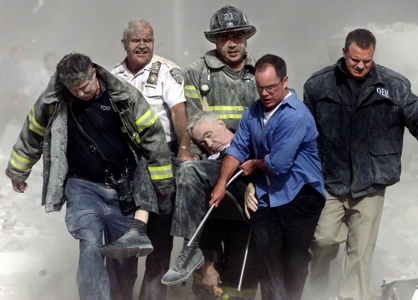据台湾“中央社”报道,一项研究于9月2日指出,暴露于美国纽约911世界贸易中心恐怖袭击的消防队员罹患癌症的风险较高;另一方面,救援队员罹患疾病风险普遍也较高。

研究今天刊在《柳叶刀》(The Lancet)医学杂志10周年纪念版。
尽管如此,科学家表示,在这场劫难幸存的救难队员与民众,死亡率却比纽约广大民众还要低。
另一项研究指出,10年前赶赴纽约市双子星大厦( Twin Towers)的消防员,罹癌机率比当时未深入险境的同事多了19%。
纽约市消防局首席医疗官员普瑞桑(David Prezant)和研究团队检视9853名男性消防官员的健康记录,时间追溯自911事件发生之前。
他们发现,当时暴露于双子星大厦的消防人员和一般民众,罹癌人数分别是263人和238人;相较之下,未进入大厦的消防员和一般民众,罹癌数则为135人和161 人。
另一方面,同样刊在《柳叶刀》的另一项研究指出,5万名曾参与911攻击救援与重建工作的人员,罹患生理和心理疾病的比例相当高。
研究人员搜集到2.7万人的健康资料,发现28%有气喘、42%有鼻窦炎、39%有胃食道逆流疾病。
纽约州西奈山医学院(Mount Sinai School of Medicine)的维斯尼弗斯基(Juan Wisnivesky)在研究报告写道,他们之中有28%罹患忧郁症、32%有创伤后压力症候群、21%受恐慌症所苦。
不过纽约市健康与心理卫生局(New York City Department of Health and Mental Hygiene)所做的另一项研究发现,当时已处于世贸中心的救援人员与一般民众,死亡率却比纽约市一般居民还要低。
生物探索推荐:
生物探索推荐英文论文摘要:
论文一:
Early assessment of cancer outcomes in New York City firefighters after the 9/11 attacks: an observational cohort study
Background
The attacks on the World Trade Center (WTC) on Sept 11, 2001 (9/11) created the potential for occupational exposure to known and suspected carcinogens. We examined cancer incidence and its potential association with exposure in the first 7 years after 9/11 in firefighters with health information before 9/11 and minimal loss to follow-up.
Methods
We assessed 9853 men who were employed as firefighters on Jan 1, 1996. On and after 9/11, person-time for 8927 firefighters was classified as WTC-exposed; all person-time before 9/11, and person-time after 9/11 for 926 non-WTC-exposed firefighters, was classified as non-WTC exposed. Cancer cases were confirmed by matches with state tumour registries or through appropriate documentation. We estimated the ratio of incidence rates in WTC-exposed firefighters to non-exposed firefighters, adjusted for age, race and ethnic origin, and secular trends, with the US National Cancer Institute Surveillance Epidemiology and End Results (SEER) reference population. CIs were estimated with overdispersed Poisson models. Additional analyses included corrections for potential surveillance bias and modified cohort inclusion criteria.
Findings
Compared with the general male population in the USA with a similar demographic mix, the standardised incidence ratios (SIRs) of the cancer incidence in WTC-exposed firefighters was 1•10 (95% CI 0•98—1•25). When compared with non-exposed firefighters, the SIR of cancer incidence in WTC-exposed firefighters was 1•19 (95% CI 0•96—1•47) corrected for possible surveillance bias and 1•32 (1•07—1•62) without correction for surveillance bias. Secondary analyses showed similar effect sizes.
Interpretation
We reported a modest excess of cancer cases in the WTC-exposed cohort. We remain cautious in our interpretation of this finding because the time since 9/11 is short for cancer outcomes, and the reported excess of cancers is not limited to specific organ types. As in any observational study, we cannot rule out the possibility that effects in the exposed group might be due to unidentified confounders. Continued follow-up will be important and should include cancer screening and prevention strategies.
论文二:
Persistence of multiple illnesses in World Trade Center rescue and recovery workers: a cohort study
Background
More than 50 000 people participated in the rescue and recovery work that followed the Sept 11, 2001 (9/11) attacks on the World Trade Center (WTC). Multiple health problems in these workers were reported in the early years after the disaster. We report incidence and prevalence rates of physical and mental health disorders during the 9 years since the attacks, examine their associations with occupational exposures, and quantify physical and mental health comorbidities.
Methods
In this longitudinal study of a large cohort of WTC rescue and recovery workers, we gathered data from 27 449 participants in the WTC Screening, Monitoring, and Treatment Program. The study population included police officers, firefighters, construction workers, and municipal workers. We used the Kaplan-Meier procedure to estimate cumulative and annual incidence of physical disorders (asthma, sinusitis, and gastro-oesophageal reflux disease), mental health disorders (depression, post-traumatic stress disorder [PTSD], and panic disorder), and spirometric abnormalities. Incidence rates were assessed also by level of exposure (days worked at the WTC site and exposure to the dust cloud).
Findings
9-year cumulative incidence of asthma was 27•6% (number at risk: 7027), sinusitis 42•3% (5870), and gastro-oesophageal reflux disease 39•3% (5650). In police officers, cumulative incidence of depression was 7•0% (number at risk: 3648), PTSD 9•3% (3761), and panic disorder 8•4% (3780). In other rescue and recovery workers, cumulative incidence of depression was 27•5% (number at risk: 4200), PTSD 31•9% (4342), and panic disorder 21•2% (4953). 9-year cumulative incidence for spirometric abnormalities was 41•8% (number at risk: 5769); three-quarters of these abnormalities were low forced vital capacity. Incidence of most disorders was highest in workers with greatest WTC exposure. Extensive comorbidity was reported within and between physical and mental health disorders.
Interpretation
9 years after the 9/11 WTC attacks, rescue and recovery workers continue to have a substantial burden of physical and mental health problems. These findings emphasise the need for continued monitoring and treatment of the WTC rescue and recovery population.
生物探索推荐:







